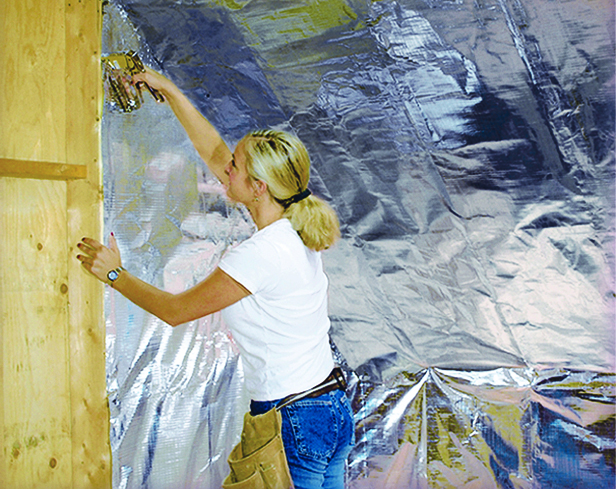Q. My air-conditioning costs are high,
but we still feel too warm at times. Ads for radiant barriers say they
save a lot. How do they work, do they save much, and what is the cost?
A: Ads about “huge” energy savings from installing attic radiant barriers are often the very maximum possible
and are exaggerated for a typical retrofit installation. But, proper installation in a specific house can yield a reasonable payback and better comfort.
Before deciding if your home is a good candidate, it’s wise to understand how a house loses and gains heat. Most importantly, the rate that heat flows from a hot
to cold area is determined by the temperature difference between the spaces. Conduction heat flows through solids that touch each other. This is how an iron skillet’s handle gets hot. The walls and ceiling of a house also lose or gain heat this way because the materials are all nailed together.
Convection is where heat flows through a moving fluid or gas, which increases the flow rate. An example is how your skin loses heat faster on a windy, winter day (wind chill factor creates a lower temperature). Radiation heat flows directly from one object to another via a vacuum, air, glass, etc. It is not dependent on touching or fluid flow. This is how you feel warm by a fire.
Radiant energy is unique because it’s affected much more by temperature difference. For conduction and convection, if indoor/outdoor temperature differences double, heat flow doubles. With radiation, the flow is 16 times greater when the difference doubles. This is why radiant barriers are most often used in the attic to block heat flow through the roof. On a hot day, the temperature of a dark shingle roof can reach 150 degrees. The roof conducts heat to its sheathing, and radiation carries it down through the insulation and ceiling, and into your house.
Radiant barriers require an air gap to keep them from touching the hot surface or they will conduct like any other material. Reinforced aluminum foil was typically used as the radiant barrier, but now many use a reflective plastic film. Be sure to check the barrier emittance level (should be lower than 0.25, or 25 percent) before buying it or signing an installation contract. Aluminum foil is well below 0.25. There are also reflective paints, such as Low/Mit (solec.org) that can be sprayed under the roof sheathing.
To get a good energy savings payback, install the barrier yourself. Companies like Innovative Insulation, Inc. (radiantbarrier.com) sell double-sided reflective foil for about $130 for a 4 x 250-foot roll. Invest in a hand construction stapler, utility knife, and a long straight edge, and you are ready to install it.
The easiest way is to cut the barrier into lengths and staple them under the roof rafters. It is not important how neatly it is installed, but it must have adequate attic ventilation—preferably both a soffit and a ridge vent. With single-sided foil, face the reflective side down to take advantage of its low emittance. It requires less radiant barrier to lay it flat over the attic floor insulation. The barrier will collect dust and may become less effective over time, so use perforated barrier material so it breathes and moisture does not get trapped in the insulation.
Savings from installing an attic radiant barrier varies considerably, depending on your climate, specific house, and orientation to the sun. The Oak Ridge National Laboratory estimates air conditioning savings can range from $150 annually for very hot climates to only $40 for cold ones. Attic radiant barriers provide little positive or negative effect in the heating season. If your electric co-op offers time-of-use rates, the savings may be somewhat higher.






